This article was posted by CrystalWind.ca.
Spanish Astronomers Claim Dwarf Sun Beyond Pluto
- Details

Spanish Astronomers Claim Dwarf Sun Beyond Pluto
by Gary Vey for viewzone
The idea of a new planet being discovered in our Solar System is pretty exciting. Even more so because of the many theories about "planet-x" or "Nibiru" being associated with space aliens and the doomsday prophecies of 2012.
Scientists at places like NASA and famous observatories have deflected inquiries about the discovery for a few years now, mainly because they feared being associated with these "fringe" theories. But like it or not -- it has happened. Well... according to a team of Spanish artronomers who call themselves the StarViewer Team.
The group made the rounds of all the news web sites in the past two weeks, claiming they discovered something very significant. It's almost twice the size of Jupiter and just beyond our furthest planetoid, Pluto. Although it's not a planet, it appears to have planets or large satellites encircling it. It's what astronomers call a "brown dwarf star" and its official name is "G1.9".
What's a Brown Dwarf Star?
First we'll explain WHAT these astronomers have discovered. Then we'll discuss HOW they discovered it.
At the risk of being scientifically vague, I'll try to explain the current understanding of how stars and planets form in space.
All matter attracts other matter. A larger mass will attract smaller masses towards it. In space this results in growing clouds of matter that tend to clump together and attract more matter. Since most of the matter in space is gaseous, these clouds eventually get so dense that they collapse into dense gaseous spheres. When they do this there is usually some "left over" matter that forms a ring around the sphere.
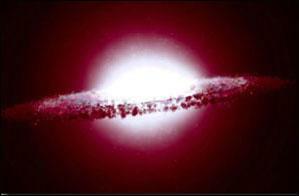 If there is enough matter in a sphere of hydrogen, for example, it can cause so much compression at the sphere's core that the hydrogen atoms begin to fuse together and a fusion-reaction ignites a new born star. In this reaction two hydrogen atoms join together to form one helium atom and release extra energy as radiation.
If there is enough matter in a sphere of hydrogen, for example, it can cause so much compression at the sphere's core that the hydrogen atoms begin to fuse together and a fusion-reaction ignites a new born star. In this reaction two hydrogen atoms join together to form one helium atom and release extra energy as radiation.
Scientists believe that the minimum mass needed to ignite a sun is about 13 times the known mass of the planet Jupiter -- written as "13MJ." If the mass is lower than this, the pressure in the core is not enough to ignite and the sphere will be hot ball of gas called a "brown dwarf."
As a new star spins, the disk surrounding it gradually cools and the matter forms heavier elements like metals and minerals. These "rocks" eventually clump together and form solid spheres called planets.
Sometimes a solid sphere will attract some of the gas that is in the disk and this will result in a gaseous giant, like Jupiter and Saturn, which has a solid core but a thick gaseous atmosphere. These "gas giant" planets can be very massive but, because of their solid cores, they will never ignite and become stars.
This Brown Dwarf
This newly discovered "brown dwarf" is believed to have formed from the same condensed matter that gave birth to our Sun. It is believed that, after the large planets formed around the Sun, they pushed it to the edge of the Solar system where it formed a sphere about 1.9MJ -- well below the mass needed to ignite it as a "sun."
|
Nemesis
The mythological Nemesis was the spirit of divine retribution against those who succumb to hubris, vengeful fate personified as a remorseless goddess. The name Nemesis is related to the Greek word meaning "to give what is due". Nemesis is now often used as a term to describe one's worst enemy, normally someone or something that is the exact opposite of oneself but is also somehow similar. For example, Professor Moriarty is frequently described as the nemesis of Sherlock Holmes. "Opposite yet similar" is the perfect description for a companion to our Sun. But the name Nemesis also implies a sinister nature. Will this new Nemesis be beneficial or harmful to our lives? |
Many suns that we observe in the galaxy are part of binary systems or double stars. There is debate about how two suns form from a single condensed cloud of matter. Some believe that they both form at the same time; others believe they split following the creation of one huge sun.
Sometimes both spheres are capable of fusion and both suns shine brightly, encircling each other around an imaginary point call the barycenter. Sometimes only one sun attains 13MJ and ignites, while its smaller companion, the brown dwarf, glows dimly and radiates heat. Astronomers usually can only see the brightest of the two, but because they both circle around a common barycenter, the wobble reveals the mass of the unseen companion.
We are close to our Sun and within its gravitational influence. So as we are travel through space, it appears to us that the G1.9 is moving in an elipse between our furthest planetoid, Pluto, and the edge of our Solar system, near the Oort Cloud.
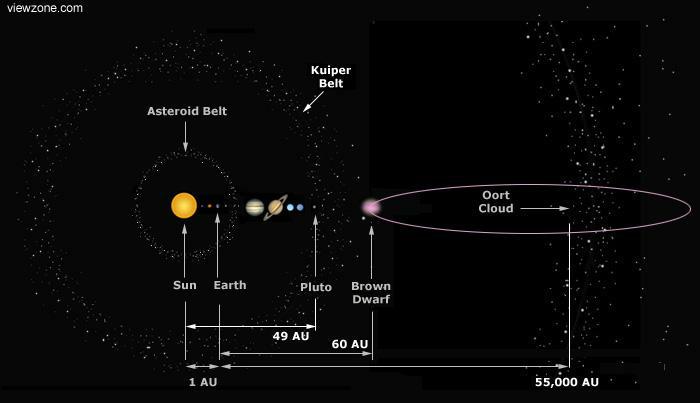
The newly discovered brown dwarf is reported to be located just about 60 to 66 AU (1 AU=the distance from the Sun to Earth) from us (its parigee), currently in the direction of the constellation Sagittarius. Because of periodic gravitational disturbances in areas of space further out, specifically in the Oort Cloud, the Spanish group of astronomers believe G1.9 travels in an elliptical orbit extending possibly hundreds of AU beyond the furthest known planets (its apogee). Its position just beyond Pluto suggests it is at its closest approach to the Sun and Earth.
Space appears relatively free of debris [see image above] inside the planetary orbits. This is because the gravitational pull of each planet (a large mass) effectively collects the interplanetary debris (small mass). But there are exceptions.
Belts of DebrisBetween Mars and Jupiter you will see a ring of debris called The Asteroid Belt. It is believed that a planet once orbited in this area before it was pulverized by some type of impact. Many theorists believe this was caused by a rogue planet that entered the Solar System -- again hinting at the existence of some unknown member of our planetary system.
As we get to the edge of the Solar System we enter another debris zone, the Oort Cloud. The Oort is not a band of debris but rather a spherical shell that surrounds the Solar System and extends out to the edge of the Sun's gravitational field. This region is thought to contain frozen clumps of water, methane, ethane, carbon monoxide and hydrogen cyanide. It's also the birth place of comets. However, the discovery of the object 1996-PW, an asteroid in an orbit more typical of a long-period comet, suggests that the cloud may also be home to rocky objects. Debris "fly-paper" Jupiter and Saturn are extremely massive and have such strong gravity that they attract meteors and comets entering the planetary zone of our Solar System. They protect smaller planets like our Earth from impacts, acting like a fly-paper for meteors, comets and asteroids In August of 2009, Jupiter captured a large asteroid that entered the planetary zone unexpectedly, despite the efforts of astronomers to track these dangerous objects. It is believed that this asteroid was perturbed by the trajectory of G1.9, which until now, was not recognized and accounted for. Note: The dark spot [ top right] in the northern hemisphere of Jupiter where the asteroid impact was. |
How it was discovered... the controversy
You might well ask why astronomers have never detected this object before. In fact they did. G1.9 was first identified as a "supernova remnant" in 1984 by Dave Green of the University of Cambridge and later studied in greater detail with NRAO's Very Large Array radio telescope in 1985. Because it was unusually small for a supernova it was thought to be young -- less than about 1000 years old.
But in 2007, X-ray observations made with NASA's Chandra X-ray Observatory revealed that the object was much larger than the last time it was observed! It had grown in size by 16%. Puzzled by this observation, the Very Large Array repeated its observations of 23 years ago and verified that it had increased in size considerably. Knowing that supernova do not expand this quickly, unless they have just exploded, they explained that G1.9 must be a "very young" supernova -- perhaps not more than 150 years old. But no record of a visible supernova has been found corresponding to that historical period (about the time of the American Civil War).
Spanish astronomers have tracked this object with great interest because they were anticipating its appearance. Gravitational anomalies have been appearing in the Oort Cloud for some time, suggesting the perturbations were caused by a nearby object with considerable mass. The announcement that G1.9 had increased in size was no mystery to them. It is exactly what they would expect as the object moved closer to Earth.
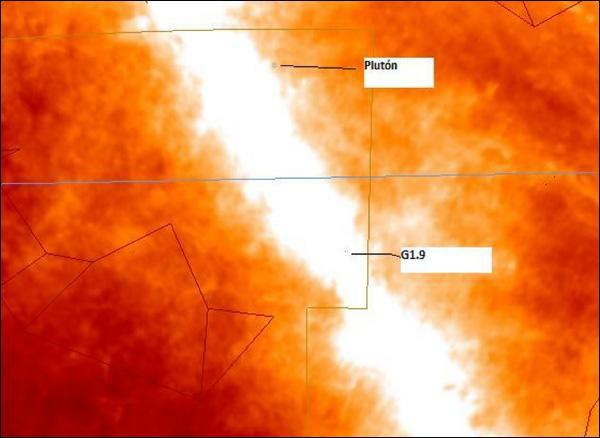
The object, G1.9 [above right] is currently located in the direction of our Galaxy's center, Sagittarius, which glows bright in this infrared spectrum image. Because of the bright background G1.9 is not visible in normal light wavelengths.
Of course there is controversy. The Spanish asrtonomers, who call themselves the "Starviewer Team" must still convince the scientific community that G.19 is not a supernova, but rather a brown dwarf star inside our Solar System. This is not an easy task. But we asked them to do just that for this article.
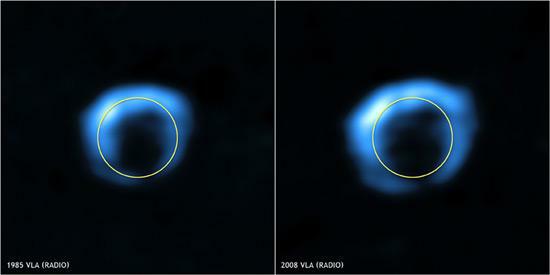
The image [above]shows the evidence that the object has increased in size over the 23 years that it has been observed. On the left, the blue spherical shape was recorded in radio wavelengths in 1985 by the Very Large Array. The image on the right shows the same view taken in 2008. It is obvious that the object is larger, but critics say that this is not because the object is closer, but rather that the residual "shell" from the exploding star has advanced out from its origin. They note the shape is not spherical but consistent with the type of remnants usually seen with supernova.
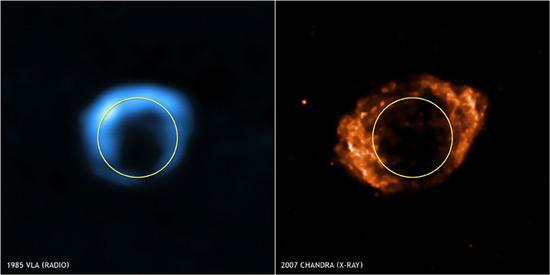
In this image [above] we see the original 1985 radio emission image from VLA compared to the 2007 x-ray image taken by the Chandra Observatory. Critics again point to the lack of central imaging (i.e. where is the brown dwarf?) and question why orbiting planets would emit irregularly shaped x-rays.
We put these questions to the Starviewer Team.
(pending their response).
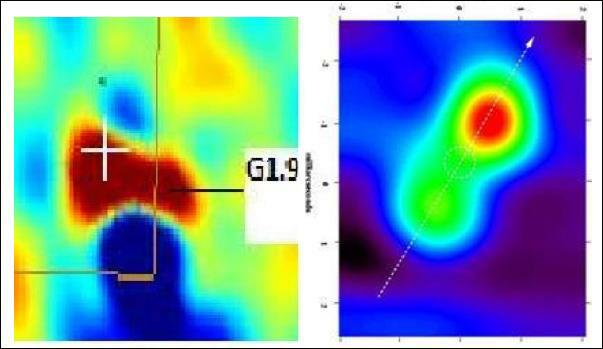
The image above was provided by the Starviewer Team. It shows the object G1.9 on the left and a known brown dwarf, Gilese 229A on the right. We are looking at microwave band emissions which indicate the radiated heat from each source. The dark red areas are the hottest. We note that G1.9 has a solid heat emission similar to Gilese 229A. The Starviewer Team seems to suggest that if G1.9 were really a supernova, we might expect that the spherical area would be cool, since the hot gas and ejecta from the exploding star would have been concentrated in the surrounding shell.
Scientists supporting the "supernova theory" remind us that the shell of a supernova is actually a sphere, meaning that the heat signature would appear circular. This supernova is also alleged to be very young -- about 150 years old -- so it would still be pretty hot. They ask us to view the heat signature os another supernova and provide an example of the infrared emission scan for Cygnus-Loop supernova below:
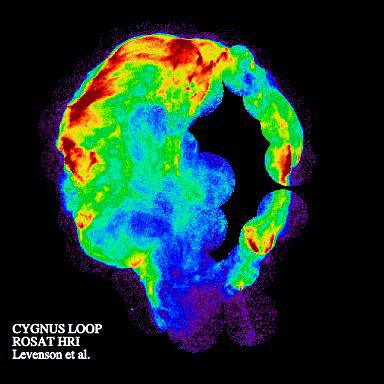
The scientists also remind us that the observations for G1.9 were made 23 years ago and the most recent observations show that the object has not moved significantly as an orbiting planet or brown dwarf would be expected to do. How do you explain this?
When we previewed this article to the Starviewer Team, we asked them to send us a rebuttal. We think we have focused on the Achillies Heel of their assertions. We waited for an answer and received the following statement, which was translated for us:
-
Some self-motivated International committee of astronomers, by their own innitiative, are presently calculating the exact orbit for the Brown Dwarf Sagitarius-Oort-Kuiper perturbation, using the StarViewerTeam's work sheets based on Lissauer, Murray and Matese's original drafts. A final report, will be published by Feb 2010.
-
There are huge scientific evidences concerning to the fact that Cosmic causes and Brown Dwarf are the real causes of Climate change. On July the 10th, Dr.Paul Clark, published on Science.com an article concerning to this matter, and almost 700 scientists signed the minority Report on climate change.
It appears the evidence is inferential and based on mathematics. So we must wait until February. I give this a validity rating (from 1 to 10) of 4.
Other Possibilities for Planet-X?
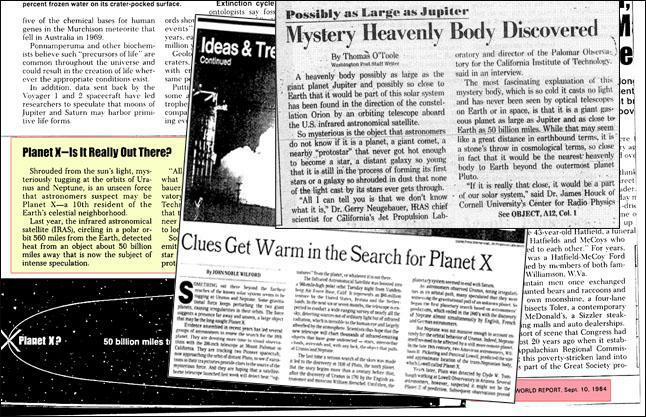
We'll mention one more, since it is the most popular one mentioned on the internet. It involved a statement made by some NASA scientists following the launch and retrieved data from IRAS, the infrared detection satellite that was launched back in 1983. A story ran in the Washington Post on December 30, 1983 with the headline, Possibly as Large as Jupiter; Mystery Heavenly Body Disccovered. Written by Thomas O'Toole it read as follows:
A heavenly body possibly as large as the giant planet Jupiter and possibly so close to Earth that it would be part of this solar system has been found in the direction of the constellation Orion by an orbiting telescope aboard the U.S. infrared astronomical satellite.
 So mysterious is the object that astronomers do not know if it is a planet, a giant comet, a nearby "protostar" that never got hot enough to become a star, a distant galaxy so young that it is still in the process of forming its first stars or a galaxy so shrouded in dust that none of the light cast by its stars ever gets through.
So mysterious is the object that astronomers do not know if it is a planet, a giant comet, a nearby "protostar" that never got hot enough to become a star, a distant galaxy so young that it is still in the process of forming its first stars or a galaxy so shrouded in dust that none of the light cast by its stars ever gets through.
"All I can tell you is that we don't know what it is," Dr. Gerry Neugebauer, IRAS chief scientist for California's Jet Propulsion Laboratory and director of the Palomar Observatory for the California Institute of Technology, said in an interview.
The most fascinating explanation of this mystery body, which is so cold it casts no light and has never been seen by optical telescopes on Earth or in space, is that it is a giant gaseous planet as large as Jupiter and as close to Earth as 50 trillion miles. While that may seem like a great distance in earthbound terms, it is a stone's throw in cosmological terms, so close in fact that it would be the nearest heavenly body to Earth beyond the outermost planet Pluto.
"If it is really that close, it would be a part of our solar system," said Dr. James Houck of Cornell University's Center for Radio Physics and Space Research and a member of the IRAS science team. "If it is that close, I don't know how the world's planetary scientists would even begin to classify it."
The mystery body was seen twice by the infrared satellite as it scanned the northern sky from last January to November, when the satellite ran out of the supercold helium that allowed its telescope to see the coldest bodies in the heavens. The second observation took place six months after the first and suggested the mystery body had not moved from its spot in the sky near the western edge of the constellation Orion in that time.
"This suggests it's not a comet because a comet would not be as large as the one we've observed and a comet would probably have moved," Houck said. "A planet may have moved if it were as close as 50 trillion miles but it could still be a more distant planet and not have moved in six months time."
I could go on and on about why this is not true. But a paper published by the same astrophysicists disclosed that the "mysterious object" was a distant galaxy -- one of the first of its kind to emit light in the infrared spectrum. The article, Unidentified IRAS sources -- Ultrahigh-luminosity galaxies appeared in the Astrophysical Journal. Here is the abstract:
AbstractOptical imaging and spectroscopy measurements were obtained for six of the high galactic latitude infrared sources reported by Houck, et al. (1984) from the IRAS survey to have no obvious optical counterparts on the POSS prints. All are identified with visually faint galaxies that have total luminosities in the range 5 x 10 to the 11th power stellar luminosity to 5 x 10 to the 12th power stellar luminosity. This luminosity emerges virtually entirely in the infrared. The origin of the luminosity, which is one to two orders of magnitude greater than that of normal galaxies, is not known at this time.
So what now? No Planet-X after all?
There's a lot of subtle fear with the approaching "doomsday" of 2012. We live in a world where the economies have failed, our governments have lied to us and there seems to be little hope. This fear is based, in part, on our collective "gut feeling" that something big and bad is on the event horizon. We sense it is something much bigger than our own obvious ineptitude at running the world. We look to space for the source of this catastrophe.
Our interest in Planet-X was first triggered by the writings of Zecharia Sitchin, whose translations and interpretations of the oldest known civilization, the Sumerians, gave us a cosmology that included what he called "The Twelfth Planet."

Sitchin's work with ancient texts, specifically the Enumma Elish, is brilliant. The cosmology includes an extra, as yet undiscovered planet, which is similar to the descriptions used by NASA and the Starviewer Team. This planet is in an eliptical orbit with a "year" equal to an amazing 3600 earth years. This long orbit is why the planet -- called Nibiru by the ancients -- has eluded observation with current telescopes and satellites.
Embedded with the cosmology of the Sumerians is the description of an alien race of beings who came to our planet to mine precious minerals and who genetically altered our species. This latter bit of the tale in the Sumerian writing has caused the cosmology to be thrown out along with the aliens. But it does not negate the cosmology.
FACTS:
There is indeed something "out there" that approximates Planet-X,Nibiru, a brown dwarf... It has been proven but not seen. Readers can explore the mathematical models that demonstrate the disruptions in the Oort Cloud, comets and our Sun in a previous article on viewzone.
At the present time we seem to be experiencing an unusually quiet period of what was supposed to be the most violent 11-year solar cycle in history. According to the theory of barycenters, this must be due to the gravitational effects of some massive body in our Solar System, preventing the usual disruptions associated with the 11+ year orbits of Jupiter.
Recent unpredicted asteroid activity suggests that something is perturbing the Kuiper Belt and Oort Cloud.
But until we can get reliable information from scientists -- or even amateurs -- who are willing to give their names and share their information for public scrutiny, we will always be suspicious when someone yells, "The sky is falling!"
Source Here
© CrystalWind.ca 2024. All content (articles, imagery, fair use) & design protected. Written permission required for copying. All rights reserved.
Join the Conversation Now! Comment Below! ![]()

Spirit Animal Totem Of The Day!
Crystal Of The Day!
Latest Articles
The Crystal Wind Oracle
Myth & Magic Card Deck!
Details Here!
NEW Expanded
Printed & Boxed!
Now with 58 cards!
CrystalWind.ca is free to use because of
donations from people like you.
Donate Now »

Unlock Your Light: Join Lightworkers Worldwide on CrystalWind.ca!
Articles: The Founders
Articles: Cosmic Neighbours
Articles: Galactic History
Follow Us!
Who is Online Now
We have 27753 guests and no members online
Featured This Month
Bright Beltane Blessings!
The wheel turns to Beltane, also known as Mayday, marking the beginning of S... Read more
Cartomancy - Fortune Telling Using Playing C…
Cartomancy is the act of divining using cards. Divining means to find out by... Read more
Taurus Mythology
The Taurus Myth The Taurus myth is most often interpreted as the story of Z... Read more
The Seven Chakras and their Meanings
If you could imagine chakras as circles of energy, flowing all the way throu... Read more
Sun in Taurus
Sun in Taurus April 21 through May 21 An Overview of Sun Sign Characteristi... Read more
The Crystal Wind Oracle Card Deck
The Crystal Wind Oracle™ The Crystal Wind Oracle Myth & Magic Card D... Read more
Frogs Return Moon
Beaver – Chrysocolla - Blue Camas – Blue April 20 – May 20 The Frogs Retur... Read more
The Time of No Time: Beltane!
Around the medicine wheel of life we go, from season to season (solstice to ... Read more

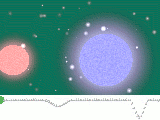 The theory of a companion sun is not new. It has often been described as Nemesis, after the Greek figure in mythology.
The theory of a companion sun is not new. It has often been described as Nemesis, after the Greek figure in mythology.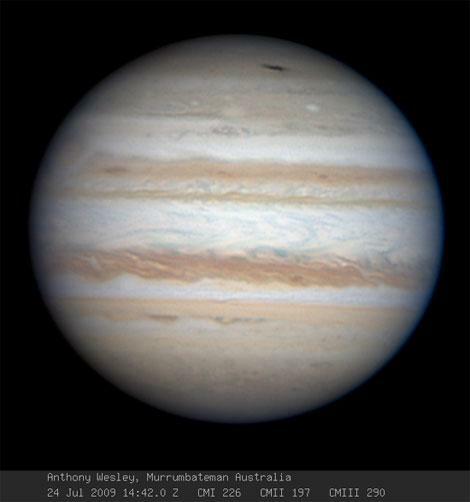 Beyond the furthest planetoid, Pluto, there is a large ring of debris called the Kuiper Belt. While the asteroid belt is composed primarily of rock and metal, the Kuiper belt objects are composed largely of frozen volatiles (termed "ices"), such as methane, ammonia and water.
Beyond the furthest planetoid, Pluto, there is a large ring of debris called the Kuiper Belt. While the asteroid belt is composed primarily of rock and metal, the Kuiper belt objects are composed largely of frozen volatiles (termed "ices"), such as methane, ammonia and water.








































